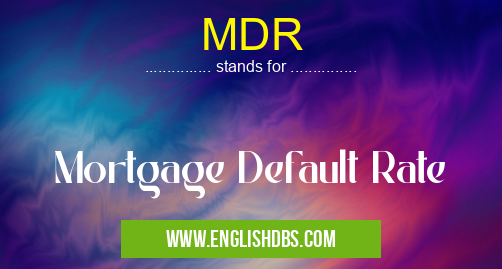What does MDR mean in MORTGAGE
MDR stands for Mortgage Default Rate, a metric used in the finance and real estate sectors to measure the rate at which mortgages have gone into default. This metric is used by lenders, investors, real estate professionals and other parties who are interested in understanding how well certain mortgage portfolios are performing. The higher the MDR, the higher the likelihood that borrowers will not be able to repay their loans. By understanding the MDR of a portfolio, lenders can make better decisions when considering what types of loans to issue and whether or not they should continue offering these products.

MDR meaning in Mortgage in Business
MDR mostly used in an acronym Mortgage in Category Business that means Mortgage Default Rate
Shorthand: MDR,
Full Form: Mortgage Default Rate
For more information of "Mortgage Default Rate", see the section below.
Essential Questions and Answers on Mortgage Default Rate in "BUSINESS»MORTGAGE"
What is a Mortgage Default Rate?
A mortgage default rate (MDR) is the percentage of borrowers who have defaulted on their mortgage payments. It is usually calculated as the cumulative number of defaults divided by the total number of mortgages in a given period. The MDR is an important indicator of how well mortgages are being managed and can be used to assess the creditworthiness of prospective borrowers.
What factors can influence a Mortgage Default Rate?
Various factors can influence a mortgage default rate, such as macroeconomic conditions, changes in interest rates, unemployment rates, and borrower characteristics. For example, when unemployment rises or macroeconomic conditions deteriorate, then it puts additional pressure on people with mortgages to make their payments on time which can increase the MDR. Similarly, when interest rates rise then this also puts pressure on borrowers as they might not be able to afford their payments any more.
How do lenders use Mortgage Default Rates?
Lenders use mortgage default rates to measure credit risk and assess whether or not a borrower is likely to repay a loan. It allows them to identify patterns based on previous history which helps them determine if they should lend money to someone or not. Lenders will often set different requirements for people with higher MDRs as they are seen as greater risks than those with lower MDRs.
Does a high Mortgage Default Rate mean that I'm unable to get a mortgage?
Not necessarily - while having a high MDR may suggest that you are more likely to default on your payments compared with someone who has a low one, lenders will still consider other aspects of your financial situation before deciding whether or not to grant you a loan. Having good credit scores and sufficient assets can help counterbalance any potential risk associated with your higher MDR.
How often does my Mortgage Default Rate change?
The MDR typically changes every month depending on how many new defaults occur against the total number of mortgages outstanding for that month. That means it’s important to keep an eye on your current score and make sure you’re taking steps to reduce it over time if necessary so you don’t end up paying higher interest rates than necessary due to having an unnecessarily high MDR.
Is there anything I can do if my Default Rate remains high?
If you find that despite making regular payments and taking other steps to improve your creditworthiness still doesn’t seem enough then you could consider refinancing your existing loan through another lender who may offer better terms than what you currently have. This may enable you to pay off your existing debt quicker and reduce your overall interest charges while at the same time lowering your MDR.
What happens if I miss my mortgage payment?
Missing one or two mortgage payments could lead to an increase in your Mortgage Default Rate (MDR). This would be particularly true if these missed payments were due multiple times over an extended period rather than just being occasional one-offs caused by temporary budgeting issues. Therefore it's important that you take steps promptly after missing any payments in order to address these arrears quickly before they become too large.
Final Words:
Mortgage Default Rates provide stakeholders with valuable information about how well certain mortgage portfolios are performing while allowing lenders to identify areas where changes could be made in order improve overall results. By understanding this metric lenders can better assess risk on mortgage products while investors can use it as an indication of potential investment opportunities or potential risks associated with certain investments – making it an important measure for anyone involved in real estate financing or investing activities.
MDR also stands for: |
|
| All stands for MDR |
